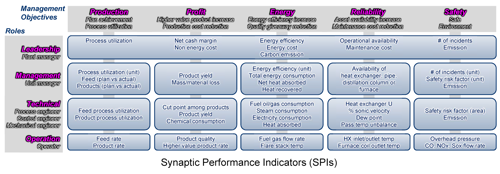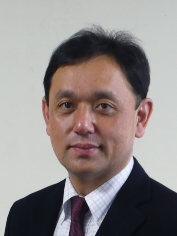2020 AFPM Summit: OT-IT integration for profit-driven operation
OT-IT integration for profit-driven operation
YASUNORI KOBAYASHI, Yokogawa Electric Corporation
Operational technology (OT)/information technology (IT) integration is required for sharing information among all levels of manufacturing organizations to achieve profit-driven operation (PDO), which helps process industry companies implement real-time production performance improvements aligned from the management level to the plant floor.
An example of how this works in practice is Yokogawa’s PDO solution, which takes production performance indicators traditionally monitored by plant management on a weekly or monthly basis, and breaks these indicators down to the technical and operations levels using industrial best practices to create synaptic performance indicators (SPIs).
These SPIs are calculated and displayed in real time by utilizing big data from the distributed control system (DCS). This information helps operators, engineers and upper management stay aligned to promptly improve production by providing performance alarms, guidance messages and a performance balance score. By using IT technologies, such as the cloud, consulting services can be incorporated to uncover additional improvements via the analysis of historical production performance parameters.
This requires the merging of expertise in OT with the Industrial Internet of Things (IIoT) and other IT technologies, along with process industry best practices, to enable production performance optimization over the lifecycle of a process plant.
Working in concert. When first introduced to PDO, some process plant personnel may confuse it with advanced process control (APC) and optimization. In reality, plants
should implement all three of these technologies working in concert. APC is used to control multiple control loops for partial process optimization, such as increasing throughput or reducing giveaway loss. Optimization is used to manage multiple APC instances for entire processes. APC and optimization are very powerful technologies, but they may not work properly if the model is not updated on a timely basis, and each is often turned off by operator turns due to a lack of deep understanding.
PDO addresses these issues by helping operators understand the effectiveness of APC and optimization through the visualization of relevant SPIs and tradeoffs. This allows operators to make the decisions required to maintain timely updates. PDO solutions leverage real-time and accurate plant big data from a DCS and integrate this data with domain knowledge to create SPIs. These SPIs are synaptically-connected from plant operation to plant management, much like the human body uses synapses to connect nerves.
SPIs encompass five main management objectives and span four levels of a process plant organization, as shown in FIG. 1. The high-level management objectives are production, profit, energy, reliability and safety. The organizational levels are leadership, management, technical and operation.

FIG. 1. Customized synaptic performance indicators (SPIs) are managed across all levels of the plant’s organization to optimize production, profit, energy use, reliability and safety.
Configuring dashboards. SPI creation requires extensive domain knowledge of the process plant’s operation. For example, by applying hundreds of personnel years of collective experience and expertise, Yokogawa and its subsidiary KBC have structured more than 2,800 SPIs for refinery operations and 800 SPIs for ethylene operations.
These SPIs must be customized for each situation because each process plant is different. Once SPIs are created, the next step is to configure dashboards. PDO software uses SPIs to configure many different types of real-time SPI dashboards. Each process unit’s home dashboard gives an overview of performance related to the five
management objectives of production, profit, energy, reliability and safety. This dashboard helps users visualize SPI balance among the five management objectives by showing what objectives are in an alarm or alert state, and what SPI trade-offs may be required to address each issue.
Clicking on a role level leads a user to another dashboard appropriate to that user’s level of responsibility. These dashboards can then be used to improve operations, as each provides not only an indication of current status, but also advice for making improvements.
PDO software automatically links all of these dashboards to coordinate actions among all levels of a plant’s organization. By providing performance alarms, guidance messages and a performance balance score, PDO helps leadership, management, and technical and operation personnel stay aligned to promptly improve production performance.
Operation and technical personnel rely on OT to view dashboards and take actions, while management and leadership more often employ IT to view dashboards and provide advice. OT/IT integration is therefore crucial because it allows information to be communicated in real time across all levels of the organization.
OT/IT integration is also essential for enabling consulting services from external experts located remote from the plant. Cloud, digital twin and other IT services allow plant data to be communicated globally. Experts analyze these data and provide the plant with recommendations for additional improvements.
PDO helps end users shift from process control to performance control by applying real-time management of SPIs. In addition to real-time profit maximization, it can also be deployed as a training tool for plant operations and technical personnel. PDO can be applied to any process plant through an approach of exploration and co-creation, with implementation accomplished in a matter of months.
For more information, visit https://www.yokogawa.com/us/
ABOUT THE AUTHOR

YASUNORI KOBAYASHI is a Senior Manager and Executive Consultant at Yokogawa. He has 30 years of consulting experience in process automation, and more than 10 years of management experience in R&D, marketing, sales, operations and services. Mr. Kobayashi has led projects developing new solutions, including procedural automation using AI (Exapilot), software sensors using Neural Networks (Exaneuro), real-time alarm browsers in DCS (CAMS), automation benchmarking (CEA), knowledge-based graphics using ergonomics (AOG), and remote monitoring and consulting using cloud technology (KBC Co-Pilot Program).






Comments